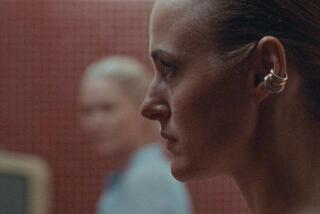Review: A well-ordered world is upended in the exquisite ‘In This Corner of the World’
- Share via
“In This Corner of the World” is as cozy as it sounds. Until it isn’t.
A prizewinner at the Annecy International Animated Film Festival, this Japanese feature is a low-key triumph, a surprisingly affecting epic of the everyday written and directed by Sunao Katabuchi, a protégé of Hayao Miyazaki who was an assistant director on the master’s “Kiki’s Delivery Service.”
Katabuchi has painstakingly made a discreet celebration of the beauty and quiet poetry of ordinary life that all but imperceptibly changes into a tribute to the resilience and sacrifices of average Japanese people during World War II.
Actually, painstaking doesn’t say the half of it, as Katabuchi spent six years researching the details of this story, and collected more than 4,000 photographs of both Hiroshima (whose central area was destroyed by 1945’s atomic blast) and the adjacent city of Kure to ensure that he got the visual details right.
Based on a manga by Fumiyo Kouno, “Corner of the World” is visually evocative, a meticulously hand-drawn, almost photo-realistic tapestry that illuminates the magic inherent in the most commonplace situations.
Unhurried yet involving, it’s also a voyage back in time to Japan between the years 1933 and 1946. It casually immerses us in a well-ordered world where people looked out for each other even when a war no one had asked for completely upended their lives.
The prime mover in this story is Suzu (voiced by Rena Nounen), introduced as a shy girl who tells us “I’ve always been a dreamer” right off the bat.
Someone who sees ghosts in everyday life, Suzu is treated as nobody special by those around her, but we see things in her that others don’t.
Living near the water in Hiroshima, the child of a family that earns a living gathering and drying seaweed, Suzu grows up a fantasist who loves to draw but who is so poor that the gift of a new pencil from a boy she has a crush on is a major event.
Even in these early stages, the everyday nature of Suzu’s life is what interests filmmaker Katabuchi. We accompany the young girl as she prices various candies, visits her grandparents and the graves of her ancestors and makes up stories that make her younger sister laugh.
Suzu is so involved in her own world that she is taken by surprise when Shusaku (Yoshimasa Hosoya), a young man she doesn’t remember meeting, asks for her hand in marriage. “I guess I’m becoming an adult,” she says to her sister before accepting Shusaku’s offer.
Suzu moves in with her husband’s family in Kore, where everyone, including Shusaku, works for the Imperial Navy. And though the marriage was an arranged one, she and Shusaku grow deeply attached to each other.
An instinctively helpful person, Suzu becomes consumed by the day-to-day housework in her new family home, endless cooking and cleaning we are shown in detail. Similarly, when Shusaku’s bossy sister Keiko (Minori Omi) moves in, Suzu takes it in her stride and forms a sweet bond with Keiko’s young daughter, Harumi (Natsuki Inaba.)
Everything intensifies when the war and its privations take over everyone’s lives, and Suzu has to cope with extreme rationing, civil defense lectures and, in one sequence that is both amusing and frightening, being mistaken for a potential spy by officious military police.
“Our battle is to survive with whatever we have,” becomes Suzu’s motto as she resorts to stratagems like an ancient samurai method for making rice last. This sense of what the homefront was like on the other side is fascinating because we so rarely see it.
When the war gets closer to home, when American bombing becomes increasingly frequent, the tone of “In This Corner of the World” darkens, and Suzu and her family have their own personal tragedies to deal with.
The Aug. 6, 1945, atomic bomb attack is of course depicted, but it is typical of Katabuchi’s visual gifts that it is not dealt with in an expected way.
In its visualization of a life that feels exceptional as well as ordinary, “In This Corner of the World” draws us in with the beauty of its animation and the specificity of its detail.
Suzu’s story becomes so deeply personal that when an animated hand waves at the audience at the film’s conclusion, we will feel like waving back, like we would to a friend.
< ###<
“In This Corner of the World”
No rating
Running time: 2 hours, 9 minutes
Playing: In select theaters
See the most-read stories in Entertainment this hour »
Movie Trailers
More to Read
Only good movies
Get the Indie Focus newsletter, Mark Olsen's weekly guide to the world of cinema.
You may occasionally receive promotional content from the Los Angeles Times.











